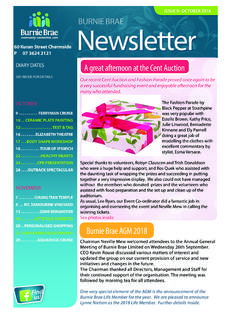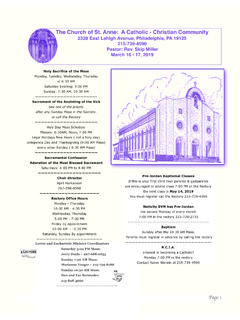Transcription of Literature Circles and the Heart of Response (Grades 1-8)
1 Literature Circles and the Heart of Response (Grades 1-8). Bonnie Campbell Hill AISA Conference Mbabane, Swaziland, october 11, 2008. Kampala, Uganda, october 20, 2008. Index Why Literature ? .. 1. What Literature Circles Are and Are Not .. 2. Literature Circles : Primary .. 3. Literature Circles : 4. Literature circle Structure: 3rd/4th 6. Literature Circles Structure: Intermediate .. 8. Literature Circles Structure: Middle School .. 9. Making Discussions 12. Preparing for Literature circle 13. Literature circle Bookmark .. 14. Anecdotal 15. Focus Questions for Anecdotal Notes: Literature 16. Literature circle 17. Literature circle Debriefing .. 18. Literature Discussion 19. Discussion 20. Response Journal 21. Journal Response 22.
2 Journal 23. Two Stars and a Wish .. 24. Presentation Rubric .. 25. Literature circle 26. Change Over 27. Professional Resources: Literature 28. Books to Read .. 36. Why Literature ? Because Literature has the power .. to make us more human, to help us see the world from inside the skin of persons very different from ourselves; to live more lives than the one we have; to try on various roles. to develop compassion and insight into the behavior of ourselves and others (through characters so real that the reader lives and suffers and rejoices with them). to show us the past in a way that helps us understand the present. to move us in ways that facts, statistics, and history texts can never do (or rarely do). to develop the imagination; to help us entertain ideas we never could have had.
3 To interpret and translate our experiences, to shape our world, and to enlarge our imaginations. to take us out of ourselves and return us to ourselves as a changed self; to enlarge our thinking while educating our hearts. Huck, C. S. (1987). To know the place for the first time. The Best of the Bulletin. Children's Literature Assembly/National Council of Teachers of English, 1, 69-71. Literature Circles Overview What Are Literature Circles ? In Literature Circles , small groups of students gather together to discuss a piece of Literature in depth. The discussion is guided by students' Response to what they have read. You may hear talk about events and characters in the book, the author's craft, or personal experiences related to the story.
4 Literature Circles provide a way for students to engage in critical thinking and reflection as they read, discuss, and respond to books. Collaboration is at the Heart of this approach. Students reshape and add onto their understanding as they construct meaning with other readers. Finally, Literature Circles guide students to deeper understanding of what they read through structured discussion and extended written and artistic Response . Katherine L. Schlick Noe & Nancy J. Johnson. (1999). Getting Started with Literature Circles . Norwood, MA: Christopher-Gordon Publishers, Inc. Page 1. What Literature Circles Are and Are Not . Literature Circles are .. Literature Circles are not .. Reader Response centered Teacher and text centered A component of a comprehensive literacy The entire reading curriculum program Groups of readers formed by book choice Teacher-assigned groups formed solely by ability Structured for student independence, Unstructured, uncontrolled "talk time".
5 Responsibility, and ownership without accountability Guided primarily by student insights and Guided primarily by teacher- or questions curriculum-based questions Intended as a context in which to apply Intended as a place to do skills work reading and writing skills Flexible and fluid; never look the same Tied to a prescriptive "recipe". twice Literature Circles in a Comprehensive Literacy Program Read Aloud Opportunities for Application ( , Literature Circles , inquiry study, content area reading and writing). Guided Reading and Writing Katherine L. Schlick Noe & Nancy J. Johnson. (1999). Getting Started with Literature Circles . Norwood, MA: Christopher-Gordon Publishers, Inc. Page 2. Literature Circles : Primary I use Literature Circles every other week, providing an emphasis on choice reading and predictable books with rhyme, rhythm and repetition during the alternate weeks.
6 Friday: I read all of the picture books aloud, and give a book talk on any chapter books. There are usually 3 - 4 selections. Papers are posted with the title of each book and numbers below to indicate the number of students who may be in that group. The books are set below the papers to provide a visual reminder. I. draw names from a jar, and write each student's name under the selection they choose. If the last few students have no choice available, their names are marked with a star to indicate that they will be able to choose first for the next Literature Circles . Monday: All students read their book. This occurs in a variety of ways: - The whole group (from 5 - 7 students) meets in a circle and the book is read aloud (with pauses for discussions, predictions) by me, an assistant, or a strong student reader.
7 Each student follows along in their copy of the book. - Students listen to a tape of their book at the Listening Center, following along in their copy. I record all books that we use in Literature Circles . - Students partner read. - Students read on their own. - Students read with a 6th grade tutor. Students then respond to the book in their Literature Log through writing and drawings. Tuesday: Discussion. I meet with two groups to talk about the story. Each child brings their copy of the book and their Literature Log. Each group also reads their book again (or continues reading in longer books), and responds in their Literature Log. Wednesday: Read. Projects. Students meet in their groups to talk about project choices, and then begin projects.
8 These may be group, partner, or individual projects. I also meet for discussion with any groups I was unable to meet with on Tuesday. Thursday: Complete projects. Record project in Literature Log. Friday: Share projects. Share and read favorite parts of the book with groups. st nd Holly Dietrich, 1 / 2 Grade, Cedar Valley Elementary, Edmonds, WA Page 3. Literature Circles : Structure Choosing Books A model I follow is, "I choose, we choose, you choose." This model will cover the whole year starting in September/ october when I choose a book the whole class will read so we can focus on learning how to discuss and respond to Literature . Later in the year, I. want students to start picking their own books, so we choose together.
9 I also want student groups to start reading different books based on a theme. Finally, when they're ready, they choose by themselves from the several options I provide. Introducing Books At the start of each round of Literature Circles I introduce books based on our theme. Students pick their top three choices and groups naturally form. However, it may be necessary that I place students in groups based on their second or third choice or based on group dynamics. Student Schedule I assign an ending date for students to be finished with their books. Each group negotiates its own reading schedule. Teacher Schedule I teach in a district that recently adopted a new reading curriculum that includes an integrated reading anthology, language arts workbook, and spelling workbook.
10 Since there is a strong emphasis on this curriculum, I alternate between working in the anthology (to teach reading strategies) and doing Literature Circles (to apply reading strategies and develop Response ). We will have Literature Circles on Tuesdays and Thursdays and work in the anthology on Mondays, Wednesdays, and Fridays. Literature circle Schedule Students use their journal entries as a jumping-off point for discussions. Groups assign themselves two or three journal prompts for each round. After students share their journal entries, they discuss what their next assignment will be. Students self manage their groups, picking an order of sharing and assigning a noise monitor and task master to keep the group on track.




